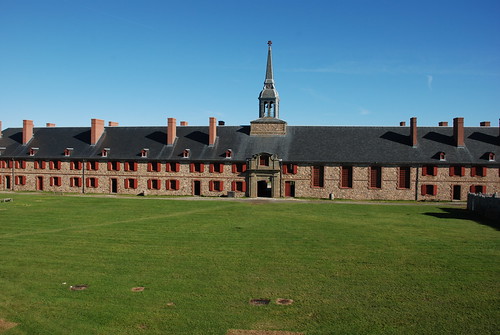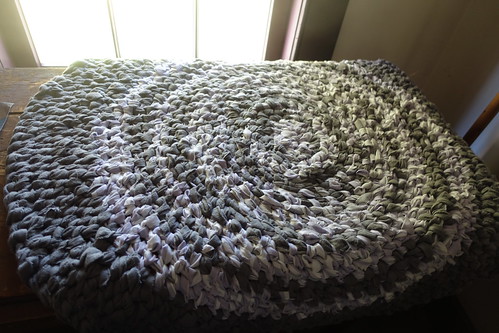Passengers aboard a New England to Canada cruise oftentimes visit Sydney, located on Cape Breton, an island that is part of Canada’s second-smallest province, Nova Scotia. Last fall, my Celebrity Cruises itinerary included an eight-hour stop in this port.
To get a taste of this region’s history, I divided my time by taking a half-day Celebrity Cruises shore excursion to the Louisbourg Lighthouse, followed by a guided tour of the Fortress of Louisbourg, and concluded with a self-guided tour of the easy to navigate coastal town of Sydney. Like most Americans, I was totally unfamiliar with Nova Scotia’s history. Thus, I was eager to find out more about the historic capital of Cape Breton.

Adjacent to the Joan Harris Cruise Pavilion, passengers are greeted by the world’s largest fiddle. Almost everyone who disembarks from a cruise ship takes a photo of this 17-meter tall landmark. It is made of painted steel, and commemorates the community’s love of Celtic folk music that was brought to Cape Breton by Scottish immigrants more than 200 years ago.

Sydney Fiddle
While preparing for my visit, I was surprised to learn some key facts connecting America’s early history with Nova Scotia. In the 18th century, Nova Scotia was adjacent to the Massachusetts colony. On a few occasions, a delegation of Nova Scotians tried to unite forces with the colonists. George Washington and the Continental Congress in Philadelphia did not support these endeavors. Some historians wonder if Nova Scotia would have become a 14th colony had the colonial leadership been receptive to their overtures and had more Nova Scotians shared the colonists’ sentiments. In the aftermath of the American Revolution, a substantial number of Loyalists fled the colonies and settled in Sydney, other parts of Nova Scotia, New Brunswick, Quebec, and Prince Edward Island. King George III offered free land in British North America to any Loyalists who chose to leave the 13 Colonies.
Governor Joseph Frederick Wallet DesBarres established Sydney in 1785. He named this coastal settlement in honor of the Secretary of the State, Lord Sydney. This town was the capital of the Colony of Cape Breton until it became part of Nova Scotia in 1820. An influx of Scottish immigrants settled in the town in the first part of the 19th century and Eastern European immigrants followed in the latter part of the century.
HALF-DAY SHORE EXCURSION
Louisbourg Lighthouse
One notable feature of New England to Canada cruises is the preponderance of lighthouses. Each provides a photo opportunity and a nugget of history. This particular location is the site of Canada’s first lighthouse. The French built a lighthouse in 1731. To minimize shipwrecks, a new, more effective lighthouse was built in 1842. After a fire destroyed the two-and-a-half story wooden building, the present day lighthouse was built in 1923. The position of lighthouse keeper became obsolete when the lighthouse was automated in 1990.
If time allows, visitors can take the marked Louisbourg Lighthouse Trail that provides views of Morning Star Cove, Gun Landing Cove, and Wolfe’s Cove. Be aware that parts of the trail are rugged, and require appropriate footwear and experience traversing slippery rocks combined with high winds.
In the middle of the 18th century, battles ensued between the French and British over control of the harbor and the fortress. Nowadays, this peaceful location shows few signs of its past military history. Most will simply stop to take pictures of the lighthouse that was built in 1923, the rocky harbor coastline, and the fortress that can be seen on the other side of the harbor.

Louisbourg Lighthouse
Fortress of Louisbourg
After the War of the Spanish Succession (1701-1714), the French inhabited Ile Royal (Cape Breton) and Isle Saint-Jean (Prince Edward Island) and the British took control of Acadia and Newfoundland. In 1713, the French started to build a fortified town called Louisbourg that eventually became a prosperous community known for its fishing and trading with France, Quebec, the West Indies, and New England.
Despite steps taken to prevent a British invasion, the fortress was besieged twice. It was returned to the French after the Treaty of Aix-la-Chapelle. It was recaptured in 1758. Thereafter, the British chose to destroy the surrounding walls so that the French could never take control again.

In the 1730s, a navigation school started operating at Louisbourg. Astronomical observations made at this site provided useful information for transatlantic navigators. Joseph Bernard, Marquis de Chabert de Cogolin, supervised the construction of Canada’s first observatory, which included eight telescopes, terrestrial globes, an octant, celestial tables, and maps of the stars. Louisbourg was recognized as the center for astronomical observations in New France.
From 1713 to 1768, Cape Breton was home to 381 known slaves. A few signs focus on one of the 12 million slaves that left Africa for the New World. After being a slave for 19 years, Marie Rose (1717-1757), was freed. Records indicate that she was married to a Mi’kmaq, who belonged to the First Nations People who were indigenous to Canada’s Atlantic Provinces. Together, the couple owned and operated a tavern, an unusual occurrence for those times.
In the 1960s, the Canadian government decided to restore about one quarter of the original site to its mid 18th century glory by using approximately 750,000 pages of original documents and 500 maps from archives in France, England, Scotland, the United States, and Canada. Today, the Fortress of Louisbourg is one of the largest national sites in Canada and is the largest reconstruction project in North America.
Visitors can witness highly skilled re-enactors dressed in 18th century costumes who provide short presentations in various places around the fortress. Informative signs are scattered throughout the site. Guests can use a printed map, highlighting 36 places, as a guide.

During my visit, I listened to a re-enactor describe his musket and sword, and then watched as he loaded the barrel and fired into an open field. I also visited the royal military engineer’s residence, where I listened to a knowledgeable woman talk about family life at the fortress. She shared some interesting facts. Approximately 50% of the children died before they were ten years old. The children didn’t eat with their parents. They were to be seen, but not heard, and all sons were expected to follow in their father’s footsteps. A slightly bitter cup of hot chocolate mixed with cinnamon and nutmeg was served to everyone before we toured the small home.

Inside a kitchen at Louisbourg Fortress
After the structured portion of the tour, I explored the perimeter to observe the restored fortification and looked back toward the lighthouse as a flock of sheep passed by. Since it was mid-October, only a handful of the dozen or more buildings that are usually available for touring were open. I peeked inside some of the windows and then simply strolled up and down the walkways, trying to imagine life in the 18th century, without the aid of the hundreds of re-enactors that usually provide insight into daily life.
SELF GUIDED TOUR OF THE PORT AREA
After the bus dropped the tour group back at the port, I walked a few blocks to the oldest part of town, North End Sydney. I passed a sign for Mariner’s Park, a park that memorializes the merchant seamen who lost their lives during wars. Within a two-block radius, I saw placards that identified several historical sites—the Jost House pamphlet indicates that there are six buildings constructed in the late 18th century and two from the beginning of the 19th century. I had time to walk into two tiny museums and also visited the St. Patrick’s Church before returning to the ship.
Cossit House Museum
Loyalists Reverend Ranna and Thankful Cossit, from Claremont, New Hampshire, built this house in 1787. Ranna was the first Anglican minister in Sydney, and led services at the nearby St. George’s Anglican Church. After giving birth to her thirteenth child, both Thankful and her baby died. A few years later, Reverend Cossit moved to Yarmouth, Nova Scotia, and the house was left to some of the Cossit’s children. In 1976, the Province of Nova Scotia and the Old Sydney Society purchased the property and opened it as museum the following year.
For a small admission fee, visitors can tour the post and beam constructed home that, like other homes from this era, had no insulation. The walls and ceiling were made of plaster composed of burnt and crushed seashells mixed with hair.
The wooden floorboards creaked as I went from one small room to the next. On the desk in the sitting room is a letter book that was used by Ranna. According to a posted sign, letter writers would copy their letters before they were sent. This standard procedure helped them remember the contents of a letter since it could take a very long time to receive a reply when letters were transported by horseback and ship.
Instead of the modern convenience of a stove, meals were cooked over an open-hearth fire in the kitchen. The family used pewter plates that were made with lead that eventually could have poisoned them. Adjacent to the kitchen was a narrow rectangular room with a rocking chair and thin bedding on the plank floor. Thankful delivered six of her children in this modest room.

Birthing Room in Cossit House
A rag rug is displayed in one of the rooms. Poorer immigrants brought this technique to the New World. Scraps of worn out fabrics were used to create these floor rugs. A quick online search revealed that rag weaving was a worldwide craft that was common among North American immigrants.
A narrow and steep stairway led to the second floor that had four modest bedrooms; a set of stairs went upward toward the attic. While only a couple of rooms were open, I witnessed the limitations of 18th century living.

Jost House Museum
This small house was built in the late 18th century. For several decades the home had numerous owners. After Thomas Jost purchased the home in 1836, its title remained in the Jost family until it was sold in 1971. Since the average height of a man was 5 feet 4 inches and a woman 4 foot 10 inches, the ceiling heights are very low. Guides dressed in colonial era clothing shared colorful comments in each room.
Almost every inch of wall space was covered with pictures or memorabilia that shed light on several centuries of regional history. In the Victorian Room, there was a collection of Church Plates. A Passover Seder plate and ceramic matzah holder represented the small Jewish community. Handcrafted Ballem tapestries from the last quarter of the 19th century were also showcased. One small upstairs room had an apothecary exhibit with medicinals from the 1930s and 1940s, while another showcased Sydney’s maritime history with a collection of models and historical texts.

Bedroom in Jost House
The basement highlighted life back in 1786, when Samuel Sparrow occupied the home. The beams, bricks, and stonework are the original materials. The kitchen was the focal point. In that time period, the kitchen fireplace would have been operating 24 hours a day, even in the summer months. A beehive oven was used to bake bread.

Basement fireplace in Jost House
A tremendous amount of history was jammed into this small home.
St Patrick’s Church
The structure dates back to 1828. It replaced the original wooden chapel that was built a few decades earlier by Captain John Butler Wilson. After Captain Wilson’s death, his widow donated the chapel and adjacent graveyard to Sydney’s first resident priest. He arranged for the construction of a gothic styled church called St. Patrick’s. Since then, the church was renovated numerous times. The Old Sydney Society converted the church into a museum in the 1960s.
Concluding Thoughts
In Sydney, Nova Scotia, it’s easy to step back to the 18th century. Even though the town museums are small, visitors will be quickly reminded how much has changed since the 18th century. To gain a comprehensive overview of this long gone era, I recommend taking an outing to the Fortress of Louisbourg, where 19th century British and French history comes alive in full force.

Sandy Bornstein, the History Comes Alive Through Travel Editor for Wandering Educators, has visited more than 40 countries and lived as an international teacher in Bangalore, India. Sandy’s award-winning book, May This Be the Best Year of Your Life, is a resource for people contemplating an expat lifestyle and living outside their comfort zone. Sandy writes about Jewish culture and history, historical sites, family, intergenerational, and active midlife adventures highlighting land and water experiences.
All photos courtesy and copyright Sandy Bornstein except word photo, creative commons and adapted by Wandering Educators
